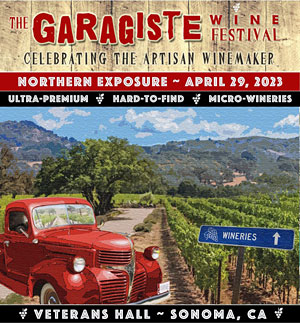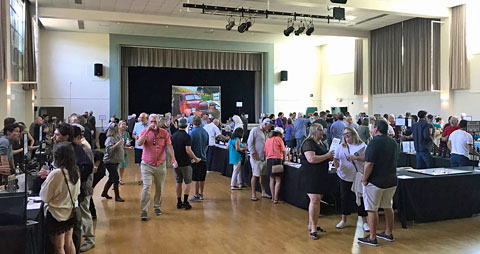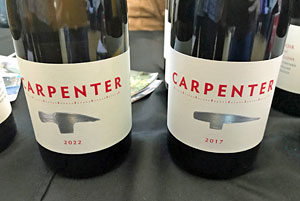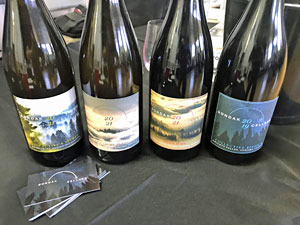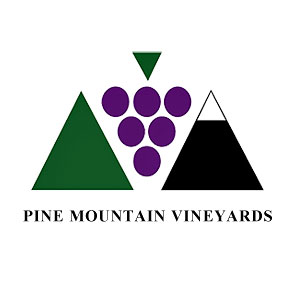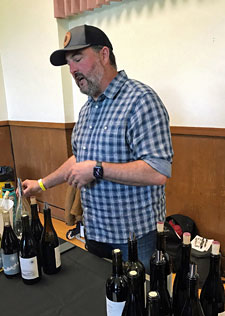Accenti / Thereafter Wines
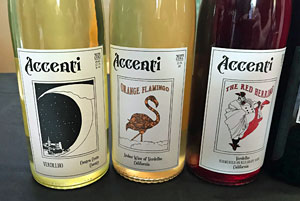 |
Accenti and Thereafter are the labels of Lorenza and James Allen, and they make their wines in Santa Rosa. Their first vintage was in 2018, and they work with regenerative and organic methods in the vineyard and minimal-intervention winemaking in the cellar. I tasted several of the Accenti wines, and the 2020 Dry Riesling from the Fountaingrove District AVA in Sonoma County was one of the standouts, displaying characteristic citrus, spice, and petrol notes with vibrant acidity – should be worth cellaring this one. Accenti poured Verdelho from Contra Costa County made in three different ways – an interesting contrast. Although their “regular” Verdelho was nice, I found the other two even better. The 2022 “Orange Flamingo” Amber Wine of Verdelho was made with three days of skin contact – this featured earthy and slightly phenolic components to go with pear and stone fruit, and mild but noticeable tannins on the finish. The 2022 “The Red Herring” Verdelho was fermented on the skins of freshly-pressed red Rhône varieties, giving it more color as well as fresh red berry aromas along with stone fruit – this wine can be thought of as a light chillable red. Accenti presented a distinctive and enjoyable lineup of wines.
Belong Wine Co.
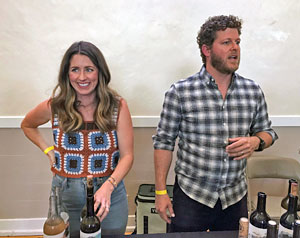 |
Bertus van Zyl and his wife Alli are the team behind Belong, which they started in 2017. Though the wines are made in Napa, they work mainly with the highly-regarded father-son vineyard management team of Ron and Chuck Mansfield in El Dorado County, and their focus is on wines from Rhône grape varieties grown in that region. I started with the 2022 “Chasing the Sunset” Rosé from Veerkamp Vineyard – 47% Mourvèdre, 28% Cinsault, 25% Grenache, whole-cluster pressed and made in stainless steel, this had both red fruit and stone fruit aromas along with a floral note, a nice texture, and lively mouthfeel. The 2019 Mourvèdre was a highlight. Sourced from five high-elevation El Dorado vineyards, 75% whole-cluster fermented, blended with 10% Syrah, and aged in neutral oak, this was bright, spicy, floral, and a bit peppery – a lighter style of this variety with plenty of acidity and milder tannins. Another standout was the 2020 Fenaughty Vineyard Syrah, fermented with whole clusters and aged in neutral oak – this had loads of dark fruit, earth, spice, and a touch of black olive on the nose, medium-full bodied with a lively texture and firm youthful tannins. This is a serious Syrah that deserves some time in the cellar. This was an impressive showing for a producer that was new to me.
Calstar Cellars
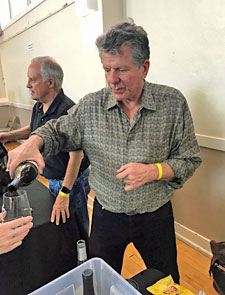 |
Vintner Rick Davis has made wine for a number of well-known producers including Flowers, Londer, and Halleck – Calstar is his own label, launched in 2001. Based in Santa Rosa, Calstar makes wines from several grape varieties, sourcing much of the fruit from cooler-climate sites. The 2016 Bennett Valley Chardonnay was fermented and aged in 30% new oak, and displayed pear and apple, spice, and a touch of vanilla/oak, with a medium-rich mouthfeel and nice acidity. The 2022 Rosé of Pinot Meunier from Russian River Valley was my favorite rosé wine of the tasting – made mostly in stainless steel, it featured bright and fresh red fruit, a touches of flowers, and a stony mineral note, with great acidity. My favorite of two Pinots I tried at the table was the 2017 Sonoma Coast Pinot Noir, sourced from Black Knight and Sangiocomo Roberts Road vineyards, and aged in 30% new oak. With raspberry and darker berry aromas along with spice, earth, and a forest floor element, this had a medium texture and enough structure to suggest that it will continue to develop nicely.
Carpenter Wines
Established in 2014 by Laura Carpenter Hawkes & Jake Hawkes, Carpenter Wines in based in the Chalk Hill region east of Healdsburg. They specialize in Sonoma Coast Pinot Noir though they also produce wine from a number of other Sonoma County grape varieties. The 2022 Trousseau Gris comes from Fanucchi-Wood Road Vineyard in Russian River Valley, and it had a bright stone fruit character plus a floral note, with a lively mouthfeel. The 2022 Sémillon from Stone Vineyard in Alexander Valley showed this variety’s bigger texture, with pear, citrus, earth, and lots of spice on the nose. I tasted a couple of clonal selections of Pinot Noir, and the 2017 Swan Clone Pinot Noir, from Old Road #3 Vineyard in the Sonoma Coast, was my favorite of the two. This featured bright red fruit, tea leaf, spice, and a stony mineral note, with great structure for continued aging.
Cazadero Winery
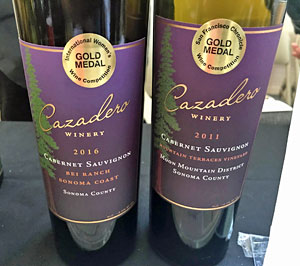 |
Frank & Ronita Egger established their winery in 2008, and it specializes in Chardonnay, Pinot Noir, and Cabernet Sauvignon from the western Sonoma Coast, not far from where Frank’s grandfather planted a vineyard in the 1920s. The wines are made in Healdsburg. I recalled that my favorites of the Cazadero wines from last year’s tasting were their Cabernets so I focused on those. The 2016 Bei Ranch Cabernet Sauvignon, from a site near the Egger’s property on the Sonoma Coast, was a highlight – this displayed an herbal character along with bright currant and plum fruit and lots of spice, a lively mouthfeel and fine tannins on the long finish. The 2011 Mountain Terraces Vineyard Cabernet Sauvignon came from the Moon Mountain AVA above Sonoma Valley, and it was a bigger wine than the Bei Ranch bottling, yet still on the lighter side compared with most California Cabs, with plummy fruit, spice, and dried herb aromas and modest tannins. These wines should be of interest to those who enjoy old-school California Cabs.
Darling Wines
 |
Proprietor / winemaker Tom Darling started his label in 2017 with a Marin County Syrah. Based in Sonoma, he continues to focus on Chardonnay, Pinot Noir, and Syrah from cool-climate vineyard sites with coastal influence. His winemaking is low-intervention and he uses little new oak. I started with the 2022 La Cruz Vineyard Pinot Gris from the Petaluma Gap – about 1/3 of the fruit had some skin contact before fermentation, giving the wine a great texture on the palate along with bright stone fruit, flowers, and vibrant acidity. The 2021 Turnstone Vineyard Pinot Noir comes from a site in the cool Sebastopol Hills area of the Sonoma Coast, and was fermented mostly with whole-clusters. This had a very savory character, with red fruit, tea leaf, and floral notes, bright acidity, and moderate tannins. The 2021 Grand Vent Vineyard Pinot Noir, from the Petaluma Gap, presented a contrast with darker fruit, earth, and spice on the nose along with a somewhat richer mouthfeel and bigger structure. A barrel sample of the 2022 Saint Marks Vineyard Syrah from the Sonoma Coast was a fine way to finish. 100% whole-cluster fermented, it had bright and floral red fruit aromas, spice, and a firm, youthful tannic structure – this showed lots of potential. An excellent lineup of wines from a producer that was new to me.
Elaine Wines
 |
Launched in 2017 by winemaker Elaine Sale, the winery focuses exclusively on Chardonnay and Pinot Noir from their own Calypte Vineyard. Located on a hillside site near Forestville, the vines were planted in 1998, with one acre of Chardonnay and two of Pinot Noir. Both Chardonnays that I tasted were barrel-fermented and aged on the lees in 50% new French oak, and both were very good, with the 2018 Calypte Vineyard Chardonnay being my favorite of the two. It featured pear and stone fruit aromas along with undertones of spice and oak, with nice acidity and texture. Nearly as good was the 2017 Calypte Vineyard Chardonnay – this had a bit less upfront fruit and more earth and spice character along with vanilla/oak notes and a slightly richer mouthfeel. The 2019 Calypte Vineyard Pinot Noir showed a lighter style of the variety, with black cherry and spice on the nose along with floral notes, a lively mouthfeel and moderate tannins on the finish. My first experience with the Elaine wines and I was impressed.
Fields Family Wines
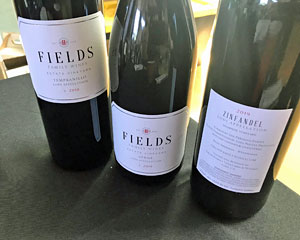 |
Owner Russ Fields purchased property for a vineyard in the Mokelumne River AVA of Lodi in 2005, and the wine label was started in 2008, and Ryan Sherman has made the wines from the start. In addition to their estate Syrah, Mourvèdre, Tempranillo, Grenache Blanc, and Vermentino, they source fruit from other Lodi growers. I started out with the 2021 Estate “Elysian Fields” – this blend of 55% Grenache Blanc and 45% Vermentino displayed bright stone fruit and tropical fruit aromas with a lively mouthfeel and flavor-packed finish. The 2019 Stampede Vineyard Zinfandel, from vines planted in the 1920s and 1940s and aged in older French oak, had loads of upfront bright berry fruit, spice, and a touch of pepper, with medium body and the structure for further development. It was interesting to taste how the 2011 Estate Syrah has developed with bottle age – it was savory, peppery, and spicy, with dark berry fruit and hints of flowers, medium-full bodied with tannins that were noticeable but not harsh.
Gondak Cellars
Proprietor / winemaker Will Gondak launched his eponymous winery with the 2015 vintage. He works with both white and red Rhône grape varieties plus a little Arneis, sourced mostly from sites in Russian River Valley and Knights Valley. First up was the 2021 “Keep It Like A Secret” Graziano Vineyard Arneis from Potter Valley in Mendocino County, with citrus, pear, and spice aromas and a medium texture. The 2021 Catie’s Corner Vineyard Grenache Blanc from Russian River Valley was a standout, with its floral, citrus, and stone fruit aromas and lively mouthfeel and finish. The 2021 Campbell McKinney Vineyard Grenache Noir from Russian River Valley was also noteworthy, with fresh strawberry along with touches of spice and herbs on the nose, fine acidity, and a clean, tasty finish.
Kendric Wines
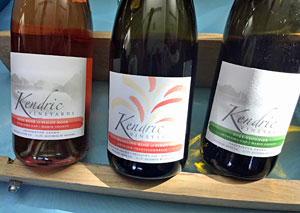 |
Kendric’s Stewart Johnson planted and farms his Petaluma Gap vineyard located in northern Marin County – he grows mostly Pinot Noir, plus Chardonnay, Viognier, and Syrah. His family also grows Sangiovese in Amador County’s Shenandoah Valley. The first vintage of the Kendric wines was in 2004. (Disclosure – I’ve helped bottle some of the Kendric wines) I decided to focus on the white and rosé wines from Kendric on this occasion – all of them were sourced from Stewart’s Marin County vineyard. I started out with an interesting comparison of samples for the upcoming 2022 Viognier, each fermented with a different yeast – Q Citrus, Q9, and U 42. As components of what the finished wine will be, the Q Citrus sample had citrus aromas (surprise!), the Q9 sample had more texture on the palate, and the U 42 sample brought out more floral character. Moving to bottled wines, the 2019 Méthode Traditionelle Sparkling Rosé of Pinot Noir, with zero dosage, was bright and toasty with notes of red fruit and earth and fine bubbles. The 2021 Viognier displayed citrus and fresh herbs with floral undertones and vibrant acidity, while the 2019 Chardonnay had earthy apple and pear aromas with a touch of spice, medium weight on the palate with a lively mouthfeel.
|
Lussier Wine Company
G.W. Lussier has worked at Pahlmeyer and Williams Selyem, and he launched his eponymous label with the 2019 vintage. He sources fruit from cool-climate vineyards in Anderson Valley and Green Valley of Russian River Valley, producing Chenin Blanc and Pinot Noir. The 2021 Jurassic Park Chenin Blanc from Santa Ynez Valley in Santa Barbara County was a pleasant start, with bright citrus and pear aromas, medium-light body, and lively acidity. In contrast, the 2021 Green Valley Vineyard “Old Vines” Chenin Blanc, from 40-year old vines in Solano County Green Valley and barrel-fermented, showed more ripe apple notes along with floral and spice undertones and more weight on the palate, quite distinctive. The 2021 “Côte de Boont” Anderson Valley Pinot Noir, sourced from three vineyards and fermented mostly with whole clusters, featured bright red fruit, flowers, tea leaf, and spice on the nose, with medium body and good structure for further development.
Murder Ridge Winery
Murder Ridge is run by proprietor / winemaker Steve Alden, who owns Perli Vineyard in the remote Mendocino Ridge AVA between Anderson Valley and the Pacific coast. The area is particularly known for Zinfandel and Pinot Noir, and those varieties are the main focus at Murder Ridge. The 2019 Perli Vineyard Pinot Noir had black cherry, tea leaf, and spice aromas medium-light body, and lively acidity. The 2019 Perli Vineyard “Potato Patch” Syrah is a field blend that includes a total of 5% co-fermented Grenache and Viognier – this showed both red and black fruits, lots of spice, and hints of flowers, with medium weight and good structure. The highlight here was the 2020 Perli Vineyard Zinfandel, with bright, brambly Zin fruit along with spice and pepper notes, medium texture, and a long, pleasant finish with fine tannins.
Parea Wines
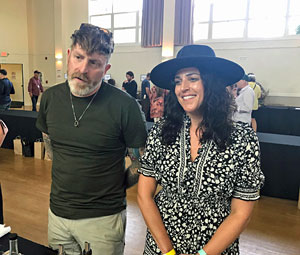 |
Parea is a new producer – a partnership of Matthew & Lauren Williams plus Peter & Shannon Stegner. Peter is the winemaker while Lauren farms the Sonoma vineyards where they source their Chardonnay and Pinot Noir. Matthew & Lauren poured wines from their inaugural 2021 vintage. From Mendocino County, the 2021 Cole Ranch Riesling comes from the country’s smallest AVA – the wine was a standout, with citrus, flowers, and petrol aromas, zippy acidity, and a long, clean finish. The 2021 H. Klopp Chardonnay, from a vineyard site on the Sonoma Coast and made in neutral oak, displayed apple and pear notes with a touch of spice, medium weight, and a lively texture. I finished with the 2021 Klopp Ranch Pinot Noir from Russian River Valley – fermented partly with whole clusters and aged in neutral oak, this was an elegant rendition of Pinot with black cherry, spice, and floral aromas, medium body, good acidity, and fine tannins. A great first showing for this new producer.
Pine Mountain Vineyards
The first vintage for the Pine Mountain label was in 2018. Their high-elevation estate vineyard in the Pine Mountain-Cloverdale Peak AVA near the Sonoma-Mendocino border is planted to Sauvignon Blanc, Cabernet Franc, and Cabernet Sauvignon. The 2019 Estate Sauvignon Blanc was a favorite at this table, showing bright citrus and tropical fruit aromas, medium weight on the palate, and a long finish. The 2019 Estate Cabernet Franc displayed ripe plum and currant notes along with herbs and touches of spice and stony minerals, with medium-full body and good structure for further cellaring.
Puppione Family Wines
Based in Forestville, winemaker Chris Puppione works with vineyard sites ranging from Sonoma County to the Sierra Foothills to the Chalone AVA. The label’s first vintage was in 2017, and the wines are made from Rhône and Bordeaux varieties as well as the Italian variety Friulano. Made with 100% Friulano from El Dorado County, the 2022 “Festa” Bianco featured bright citrus fruit, flowers, and a stony mineral note, with a lively mouthfeel and finish. The 2022 “Festa” Rosso consists of 45% Syrah, 35% Cabernet Sauvignon, and 20% Friulano – a light, chillable red / white blend, this had black cherry and plum aromas with spice, earth, and floral hints, with a tasty finish. The 2021 “Intero” Syrah, sourced from Don Miguel Vineyard in Russian River Valley, was fermented with whole clusters and showed dark berry fruit, a savory herbal component, and spice on the nose, with medium-full body and plenty of structure. Very nice wines from a producer that was new to me.
Read Holland Wines
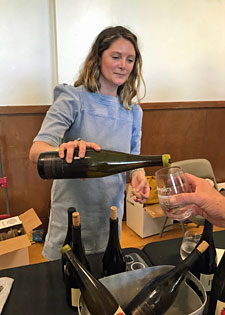 |
Ashley Holland established her label in 2016, and her focus is on wines sourced from Anderson Valley vineyards, along with some from the Santa Cruz Mountains. She works mostly with Chardonnay and Pinot Noir, along with Riesling. The 2021 Wiley Vineyard Riesling from Anderson Valley was a highlight – made in concrete, stainless steel, and neutral oak, this featured stone fruit, flowers, and petrol aromas, with medium-light body, vibrant acidity, and a long finish. The 2019 Peter Martin Ray Vineyard Chardonnay, sourced from 45-year old vines in the Santa Cruz Mountains, was made in neutral oak and displayed tropical fruit and stone fruit, spice, and floral undertones, great texture on the palate, and a lively finish. Fermented with about 45% whole clusters and aged in 25% new French oak, the 2018 “Deep End” Pinot Noir was sourced from two Anderson Valley vineyards – this showed black cherry fruit, spice, tea leaf, and forest floor on the nose, with medium weight and fine structure. My first time tasting wines from this producer, and I was impressed.
Ricci Vineyards
The family-run Ricci label was launched by Dale Ricci and Tyler Kohfeld in 2018. The estate vineyard in Carneros is the only site in California growing the Austrian grape variety St. Laurent. The wines are made by Michael Lancaster, and the fruit for the Ricci wines comes entirely from the estate vineyard. The 2021 Estate Dry Muscat – from the Muscat Canelli grape variety – was distinctively floral and perfumey but not overly so, with stone fruit undertones and good acidity. The 2020 Estate Pommard Clone Pinot Noir was savory and earthy along with plum and darker berry fruit and tea leaf notes, medium-bodied with good structure. I finished with the 2019 Estate St. Laurent, which displayed bright black cherry and raspberry, earth, smoke, and a slightly gamy component, with medium weight and tannins – it’s an intriguing wine that could easily be mistaken for a somewhat big and earthy Pinot Noir.
The Grenachista Wine Company
 |
Casey Graybehl launched his Grenachista label in 2013. His focus is exclusively on Grenache – both Blanc and Noir – and he works with vineyards in different parts of Northern California to produce a number of bottlings and styles of Grenache using low-intervention winemaking. I’d never tried a carbonic-fermentation white wine before I tasted the 2022 Carbonic Grenache Blanc from Casey’s small estate vineyard in Sonoma Valley – this featured bright stone fruit notes and undertones of orangepeel, with a zingy mouthfeel and finish. The “regular” 2022 Grenache Blanc was made in a concrete “egg” tank, and had upfront stone fruit, apple, and floral aromas, medium body, and fine acidity. The 2021 Carbonic Grenache Noir from Mathis Vineyard in Sonoma Valley displayed vibrant red fruit along with floral and spice notes, medium-light weight on the palate and mild tannins. The 2021 Grenache Noir came from a vineyard that Casey helped plant in cool-climate Napa Carneros – this was savory, spicy, and earthy, with a broader mouthfeel and moderately tannic finish, a distinctive cool-climate rendition of Grenache.
Theopolis Vineyards
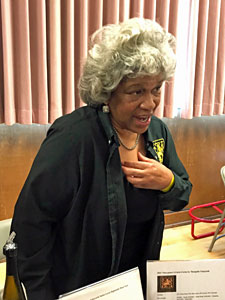 |
Theodora Lee is an attorney who also owns and farms her own vineyard in the Yorkville Highlands region of Mendocino County – her nickname is Theo-patra, Queen of the Vineyards! She planted her five-acre vineyard – all Petite Sirah – in 2003 and began producing wine under her own label with the 2012 vintage. (Disclosure – I’ve helped bottle some of the Theopolis wines) The 2021 Cortada Alta Vineyard Pinot Noir, from the Santa Lucia Highlands in Monterey County, featured black cherry and darker fruit, lots of spice, and notes of earth, herbs, and oak, with a medium-rich texture and firm tannins. I tasted two Petite Sirah vintages, and the 2018 Estate Petite Sirah – poured from a magnum bottle – was my favorite, with dark berry fruit, spice, pepper, and undertones of flowers and herbs, full-bodied with firm but not harsh tannins and a lingering finish. Nearly as good was the 2019 Estate Petite Sirah, with a similar character to the 2018 bottling, and displaying a bit more vanilla/oak along with more grippy, youthful tannins on the finish – good potential but could use more time in the cellar.
Thomas T Thomas Vineyards
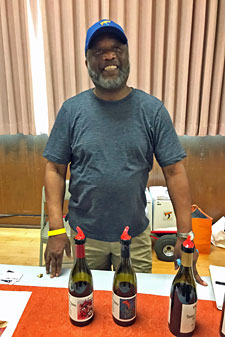 |
Thomas T Thomas farms his own vineyard near the town of Philo in Anderson Valley and makes his wine nearby. He planted the vineyard in 2008 and launched his label in 2017. He works mainly with Pinot Noir – exclusively from his estate vineyard – plus a little Chardonnay currently sourced from nearby. The 2020 Anderson Valley Chardonnay, made in 20% new French oak, showed bright pear and stone fruit aromas along with spice and earth, combining a medium-rich texture with good acidity. The 2018 Estate Pinot Noir was aged in 25% new French oak – this displayed cherry, spice, and forest floor notes with medium body and good structure. Still better was the 2018 “Buster’s Hill” Estate Pinot Noir, sourced from a single steep hillside block of the vineyard and aged 43% new French oak. Featuring bright red fruit, tea leaf, spice, and a stony mineral note, this had a somewhat bigger texture and structure than the regular estate bottling – very nice now, it deserves more time in the cellar to develop further. Really nice wines from a producer that was new to me. |


